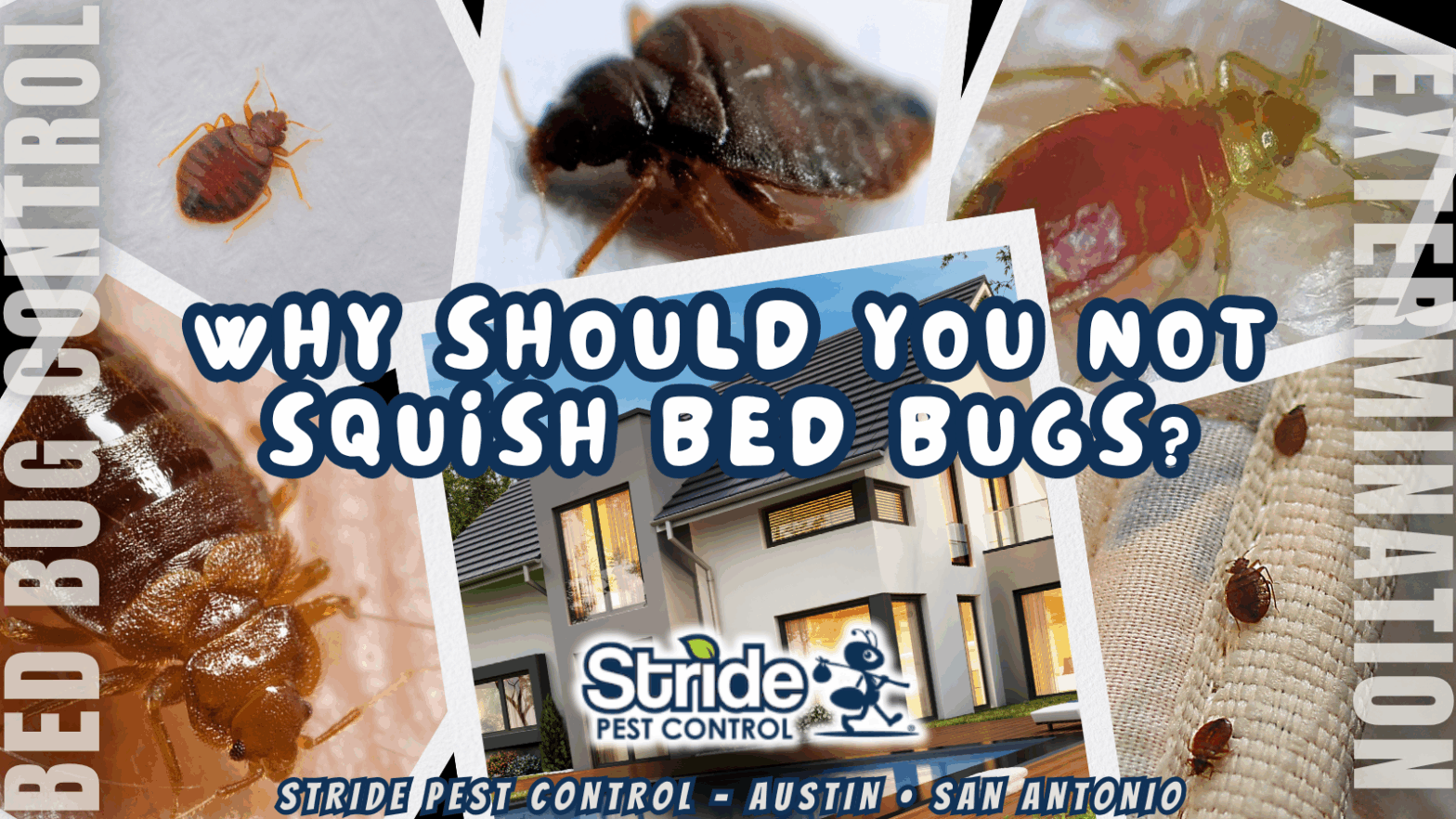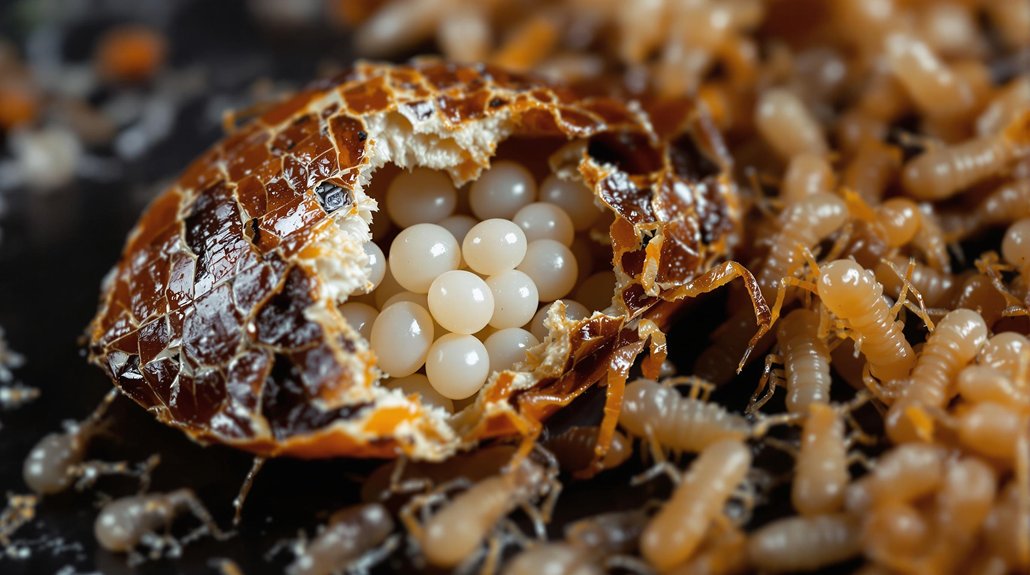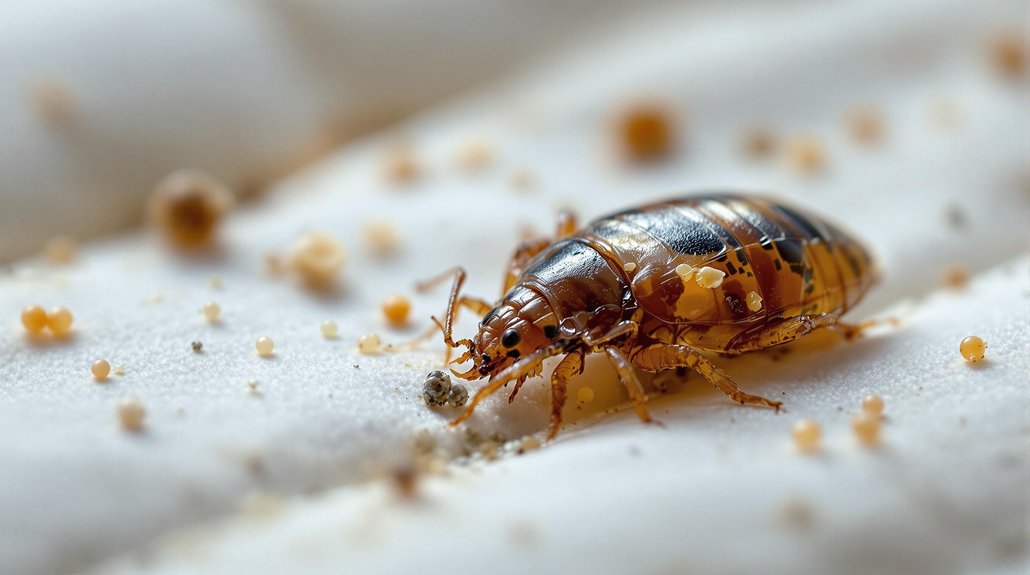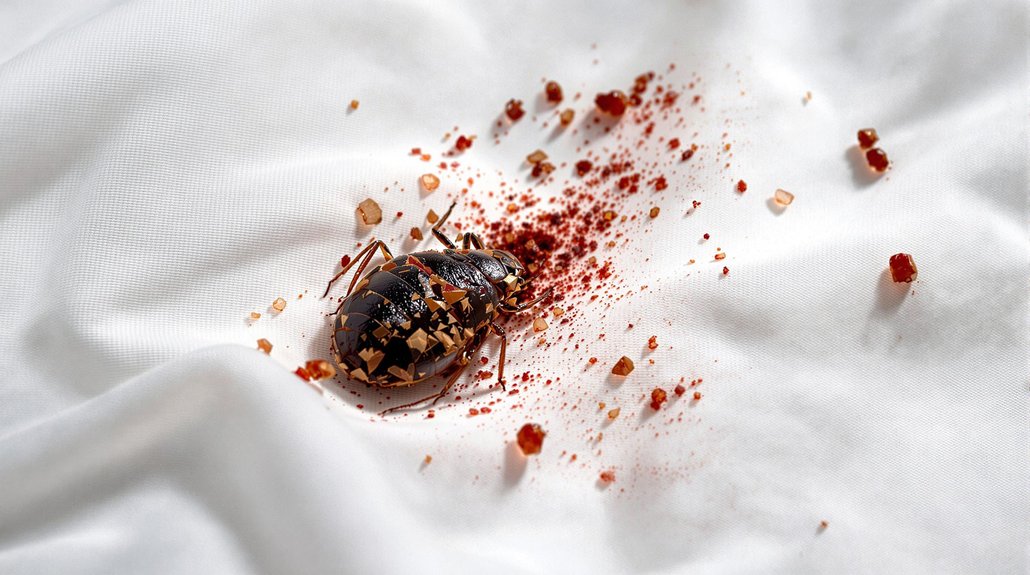
Squishing bed bugs spreads eggs, larvae, blood, and waste, making the infestation harder to control. It can cause bloodstains and waste particles to scatter, increasing health risks and contamination. Crushing bugs may provoke allergic reactions and skin irritation. It often leaves behind hidden bugs and residues that can lead to ongoing problems. Using professional methods is more effective and safer. If more details interest you, understanding these points can help in proper pest management.
Key Article Highlights
- Squishing releases eggs and larvae, spreading the infestation further.
- Crushing bed bugs disperses blood, waste, and possible pathogens, increasing contamination and infection risks.
- It can cause allergic reactions, skin irritation, and emotional distress from bites and mess.
- Smashed bugs may hide or leave behind residues that complicate complete eradication.
- Professional pest control methods are more effective than squishing for permanent removal.
Spreading Bed Bug Eggs and Larvae

When bed bugs are squished, they often release eggs and larvae into the surrounding area. This action can inadvertently spread the bed bug lifecycle, increasing infestation risk. Bed bugs lay eggs that are tiny and sticky, making them difficult to detect. Egg hatching occurs within 6 to 10 days under ideal conditions, producing new nymphs that require blood meals to mature. Crushing a bug can rupture its body, dispersing these eggs and larvae onto nearby surfaces. This dispersal can lead to the spread of eggs beyond the initial target, complicating eradication efforts. As a result, squishing a bed bug does not eliminate the problem and may worsen it by aiding the development of more bed bugs. Understanding the bed bug lifecycle emphasizes the importance of non-destructive removal methods.
Risk of Blood and Waste Dispersion
Squishing bed bugs can cause bloodstains to spread, leading to contamination of the surrounding area. Waste particles released during the crush may disperse into the environment, increasing the potential for exposure. This dispersal raises concerns about infection risks and the spread of bacteria.
Blood Spread Contamination
Squeezing a bed bug can cause blood and body waste to be expelled onto surrounding surfaces. This behavior increases the risk of contamination, spreading potentially infectious materials. Bed bugs often hide in cracks and crevices, and their blood residue can contaminate bedding, furniture, and flooring, complicating detection and removal. Proper contamination prevention involves avoiding crushing to prevent the dispersal of blood and waste particles. The table below illustrates the emotional impact of blood spread contamination:
| Emotional Impact | Reason | Effect |
|---|---|---|
| Anxiety | Unseen blood spread | Heightened fear of infestation |
| Frustration | Ineffective cleanup | Persistent health concerns |
| Disgust | Visible residue | Reduced peace of mind |
| Helplessness | Uncontrollable spread | Loss of control |
| Concern | Risk of disease | Increased vigilance |
Waste Particle Dispersal
Crushing a bed bug can release tiny waste particles, including blood residues and feces, into the surrounding environment. These waste particles are small and easily airborne or transferred onto surfaces through dispersal methods such as smearing or aerosolization. When a bed bug is squished, waste can become dispersed through contact with clothing, bedding, or nearby furniture. The dispersal of waste particles poses health concerns, as they can contaminate surfaces and potentially be inhaled or ingested. Proper understanding of dispersal methods highlights that squashing bed bugs does not eliminate contamination risks. Instead, it can spread waste particles across a wider area, increasing exposure to bacteria and pathogens present in the waste. Avoiding squashing prevents unnecessary dispersal and helps maintain a cleaner, healthier environment.
Increased Infection Risks
When bed bugs are killed by force, there is an increased risk of dispersing harmful substances such as blood and waste through the environment. This dispersion can facilitate infection transmission if hygiene practices are not carefully maintained. Bed bug debris and residual blood may contain pathogens, and spreading them increases the likelihood of contact with bacteria or other germs. Improper cleanup after squashing bugs can lead to contamination of bedding, furniture, or clothing. Additionally, microscopic blood particles and waste residues often remain after forceful killing, necessitating thorough disinfection. Mastery of proper hygiene practices is essential to prevent the spread of infection. Avoiding squashing bed bugs reduces the potential for harmful substance dispersal, thereby minimizing infection risks and maintaining a safer environment.
Potential for Allergic Reactions and Bites
Handling bed bugs by squishing them can lead to allergic reactions and bites. When bed bugs are crushed, their bodily fluids may spread, increasing the risk of allergic reactions such as skin irritation, swelling, or respiratory issues. Bite symptoms include redness, itching, and swelling, often in clusters. Squishing these insects does not eliminate the infestation and can cause more discomfort. The table below illustrates the emotional impact of these reactions:
| Emotional Impact | Effect |
|---|---|
| Anxiety | Fear of allergic reactions or repeated bites |
| Discomfort | Persistent itching and skin irritation |
| Frustration | Inability to fully resolve the problem resulting in ongoing stress |
These risks highlight why proper management is essential to avoid allergic reactions and bites.
Insufficient Elimination of Infestation

Squishing bed bugs often fails to fully eliminate an infestation, leaving behind residual pests. Repeatedly crushing bugs does not remove their eggs or hidden populations. As a result, the problem persistently remains or worsens over time.
Residual Infestation Risks
Residual infestation risks arise when bed bug populations are not fully eliminated during treatment. These residual effects can lead to continued infestation persistence, despite initial efforts. Incomplete eradication allows surviving bugs and eggs to re-establish the population over time. This ongoing presence poses a challenge, as residual insects can hide in difficult-to-reach areas and only become active later. Failure to fully eliminate the pests increases the likelihood of a recurrent infestation, making future treatments more complex and costly. Effective control depends on thorough, extensive measures that target all life stages of bed bugs. Recognizing residual effects is crucial for understanding why partial treatments often fail to provide lasting relief. Complete elimination is necessary to break the cycle of infestation persistence.
Repeated Squeezing Inefficacy
Repeatedly squeezing bed bugs on sight is an ineffective method for eliminating an infestation. This approach often fails to kill all pests and does not address hidden or inaccessible bugs. Insecticides, heat treatments, and professional pest control are more effective solutions. Relying solely on squeezing can give a false sense of progress while the infestation persists or worsens. Bed bugs reproduce quickly, making manual removal insufficient for complete eradication. Inadequate methods like squeezing can also cause bugs to scatter, spreading the infestation further. For lasting results, it is essential to explore alternative solutions that target the entire population. Professional pest control services and integrated treatments are the most reliable way to eliminate bed bugs thoroughly and prevent future re-infestations.
Risk of Damage to Bedding and Furniture
Attempting to eliminate bed bugs by squishing them can lead to unintended damage to bedding and furniture. Physical crushing risks tearing fabrics, leaving permanent stains, or damaging delicate surfaces. Such actions can complicate the process of preventing damage and maintaining furniture care.
Squishing bed bugs can damage fabrics and furniture, potentially causing stains, tears, and surface scratches.
Key concerns include:
- Staining bedding materials with blood or pest residues
- Weakened fabric strength due to crushing
- Scratched or gouged wooden furniture surfaces
- Spread of germs or debris from smashed bugs
These issues threaten the integrity and appearance of furniture and bedding items. Professionals recommend avoiding direct squishing and adopting proper pest control methods instead. This approach protects belongings, maintains a clean environment, and prevents costly repairs or replacement. Proper pest management guarantees safety and preserves the longevity of furniture and bedding.
Releasing Hidden Bed Bugs and Residues

When bed bugs are smashed, they may release blood, bodily fluids, and microscopic residues onto nearby surfaces. This releases concealed insects and their residues, complicating pest management efforts. The pests’ behavior includes hiding in cracks and crevices, making them difficult to detect. Smashed bugs can release their contents into these concealed locations, increasing the risk of spreading residues contaminated with blood and bodily fluids. These residues can linger on surfaces, potentially attracting other pests or causing health concerns. Additionally, the microscopic residues may contain possible allergens or pathogens, making their presence harder to control. Proper pest control involves removing these residues safely, rather than smashing. Interfering with pest behavior by smashing only disperses residues and hides, worsening the infestation’s complexity.
Safety Concerns for Your Skin and Eyes
Handling bed bugs without proper protection can pose risks to the skin and eyes. Squishing bed bugs may cause skin irritation from contact with their bodily fluids and debris. Additionally, accidental splashes or dust from crushed bugs can reach the eyes, leading to potential eye injuries. Direct contact increases the chance of allergic reactions and skin irritation. The airborne particles or residual fluids can cause discomfort or harm if they come into contact with sensitive skin areas or the eyes. Precautions are essential to prevent unnecessary health issues. Key considerations include:
- Avoiding direct contact to prevent skin irritation
- Using protective gear when handling pests
- Preventing dust or particles from reaching the eyes
- Washing hands and face thoroughly after handling bed bugs
Proper safety measures reduce the risk of injuries during pest management.
The Importance of Professional Treatment Strategies
Professional treatment strategies are vital for effectively eliminating bed bugs and preventing reinfestation. Relying on professional pest control guarantees a thorough approach based on proven methods, reducing the chance of missed pests or hiding spots. Professional exterminators have specialized equipment and knowledge that surpass DIY options, increasing the likelihood of complete eradication. Properly executed treatments target both adult bed bugs and their eggs, addressing all stages of development for lasting results. These strategies minimize health risks and property damage associated with improper methods. Implementing expert pest control is essential for mastering bed bug management, as it provides reliable, efficient, and safe extermination. Additionally, using heat treatment can quickly eradicate all life stages of bed bugs in infested areas. Integrated pest management techniques are also employed to address different areas of infestation comprehensively. Ultimately, trusting trained professionals guarantees a higher success rate than attempts to squish or handle bed bugs independently.

